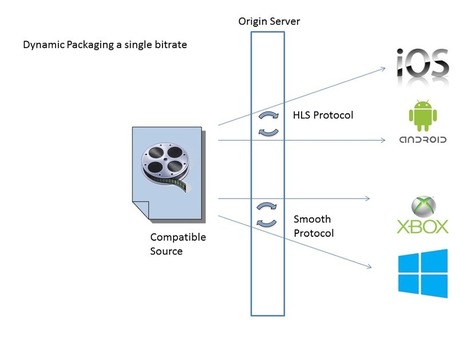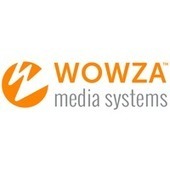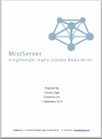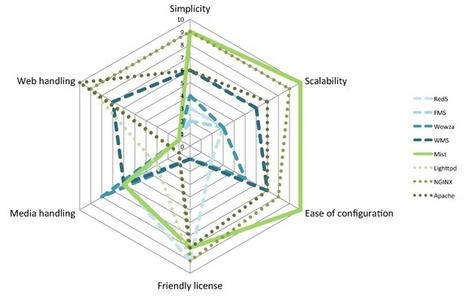 Your new post is loading...
 Your new post is loading...
For the last two years, I have been working to extend the capabilities to of the Origin Server for Window Azure Media Services. In January of 2013, Windows Azure Media Services (WAMS) became generally available as a Platform as a Service (PaaS) on Windows Azure, Microsoft’s cloud computing platform. Just over a year later, it would stream the largest live sporting event in history – millions of concurrent users and over 10,000 hours of unique content over the 16-day Sochi Winter Olympic Games. This article describes the capabilities of Microsoft’s origin server, as well as the evolution of the product in the last two years to meet today’s demanding streaming media space.
For providers trying to overcome the limitations of ABR protocols, manifest manipulation is quickly gaining traction as a solution. But which approach is right for your organization? There are several different approaches to manifest manipulation but in general they can be divided into three primary types. In these weeks blog we’ll look at them in detail, as well as the benefits and limitations of each: 1. Manifest “Conditioning” 2. Manifest Builder or “Playlist Re-writing” 3. Dynamic Manifest Manipulation (DMM)
The next-generation of CDN needs to give service providers much greater control over bandwidth priorities in the home, Alcatel-Lucent believes. If there are multiple devices competing for bandwidth, you need to be able to say that a connected television needs priority for streaming and that a smartphone should be given a lower bitrate stream, for example. “Service providers need a way to control the quality that is delivered to every screen and that is not possible today with adaptive bitrate streaming,” Mestric explains. “So in the CDN we will include a session manager that makes the CDN aware of all the different devices and session requests so that if you start to watch video on an iPhone and there is no congestion in the access network you will get the highest bitrate possible, but if someone else in the family turns on a connected TV device the service provider can then limit the bitrate profiles that can be accessed by the iPhone, for instance.” Mestric points out that session prioritization could be useful if there is contention on mobile networks. Then a content provider could prioritize a premium subscriber over a basic subscriber so they get the higher bitrate if there is no chance to provide them both with the best possible experience.
At NAB, taking place in Las Vegas April 8-11, Envivio will introduce
new products and showcase new developments in next-generation
software-based video processing that optimize the convergence of
traditional TV and multi-screen services : - An Ultra HD 4K technology demonstration
- HEVC HDTV video compression, enabling up to 50 percent bit-rate savings while preserving video quality
- HEVC video streamed to a tablet in MPEG-DASH format
- TV Anytime capabilities including applications such as Catch-up and Start-over TV, highlights creation, ad insertion and nPVR
- Introduction of a new product that further personalizes the multi-screen user experience
- High efficiency MPEG-2 and MPEG-4 AVC (H.264) statistical multiplexing
- Envivio True Motion Experience, a new technology for high-quality streaming in MPEG-4 AVC format to connected TVs
- Video packaged by Envivio Halo(TM) network media processor in the Adobe HTTP Dynamic Streaming (HDS) format, protected by Adobe Access
Does anyone have any information on the new ‘on the fly converting’ for media services?
Yes, that feature is shipping in the coming days, we refer to it as dynamic packaging, you could also call it just-in-time packaging, dynamic muxing, etc. Specifically, it will offer the ability to: Transmux from a single source format into two different streaming formats.
The actual OTT market uses Adaptive Bit Rate video format over HTTP (Smooth Streaming, HTTP Dynamic Streaming, HTTP Live Streaming and MPEG-DASH soon) to deliver the content. Although it excludes the DRMs system which is a big topic in itself, here is an overview of the different formats available for each platform and of the different solutions (self-hosted, CDN, Cloud) to handle it.
In this IBC interview, Ramin Farassat, VP of Product Marketing and Business Development at RGB Networks, provides a crisp analysis of where adaptive bit rate streaming could be heading next. It considers the use of just-in-time packaging for multi-screen nPVR and VOD, with its potential to save server storage space, and the inclusion of audio in adaptive streaming so consumers with more bandwidth can jump from stereo to 5.1 surround sound. He also outlines why some operators are conducting friendly trials with ABR set-top boxes, hoping to unify all video infrastructure around IP ABR video.
Video-processing solutions vendor Elemental Technologies is debuting a server aimed at cutting bandwidth and storage needed for multiscreen-video distribution, by packaging streams closer to end users. Using Elemental Stream, video can be sent over a CDN in a single encoded video format and then specific digital rights management and adaptive bit-rate formats can be applied at the time of distribution. The company expects the product to be generally available in the third quarter of 2012. The new server supports closed captioning and subtitle conversion, SCTE-35 advertising triggers and can associate a single video with multiple audio tracks. Elemental Stream packages video to support existing and future adaptive bit-rate protocols including Apple HLS, Adobe Dynamic Streaming, Microsoft Smooth Streaming and MPEG-DASH. Supported DRMs include Microsoft PlayReady, Verimatrix VCAS and Motorola SecureMedia.
RGB Networks today announced that its award-winning TransAct Packager now supports the MPEG Dynamic Adaptive Streaming over HTTP (MPEG DASH) protocol. Adding this to its support for Apple HTTP Live Streaming (HLS), Microsoft Smooth Streaming and Adobe HTTP Dynamic Streaming (HDS), RGB’s TransAct Packager is the only packager to support all four protocols in live and on-demand environments. As part of its efforts to enable industry-wide adoption of MPEG DASH, RGB is working closely with developers of the client media players necessary for displaying MPEG DASH video, including AuthenTec and Netview Technology. Integration with these two vendors has been tested and will be demonstrated at NAB 2012.
A good overview of the major features implemented in 2011 inside USP repackaging software : - PlayReady encryption key exchange with BuyDRM's KeyOS Smooth DRM Service - Verimatrix iOS key exchange - support for MPEG DASH draft specification - Proxy support (NFS, S3, Windows Azure)
... and what's coming in 2012 : - Selective scrambling - Flash access DRM - Full MPEG-DASH support - support for UltraViolet's Common File Format, using Common Encryption
Multi-screen TV is approaching a tipping point now as the Pay TV pioneers look to expand their offers to cover more channels as well as more devices, and more service providers launch TV Everywhere packages. One of the important tasks for many operators walking around IBC this year is to work out how they can scale their multi-screen services beyond a sub-set of the channels they offer on the set-top box. Ultimately consumers will expect all their channels on all screens, of course. Reviewed approaches are the ones of : Ericsson RGB Networks Harmonic Envivio Imagine Ateme
WebM is surely one of the hotest streaming topics right now, because WebM is one of the two final HTML5 video standards with H.264. When Google bought On2 in 2009 and open-sourced its latest VP8 codec one year later, two promises were made : providing a codec which quality can compete with H.264 , and providing it in a royalty-free way. On the quality point, the general opinion is that the VP8 codec is slightly less performing than H.264– but it can be an acceptable trade-off regarding the royalties point. Precisely, the royalty-free point is the one which raises the more questions now, as MPEG-LA is said to have a lineup of 12 patent owners ready to claim their rights on intellectual property, as VP8 would use compression techniques taken from H.264. Seeing their fight against Google being a success would cause a major setback in HTML5 standardization efforts around open source solutions – WebM then being another coding technology subject to royalties after H.264. Nevertheless, the patent war has not started yet and WebM is still a good alternative to H.264, on the paper. And that’s why we are curious to know how we can implement it in our existing or upcoming workflows. So let’s walk through the different steps of the WebM streaming workflow !
|
Expect big changes from the renamed Wowza Media Server, which now offers a GUI. Both first-timers and power users will be happy about it.
Just how much faster does the new graphical user interface (GUI) make setting up Wowza Streaming Engine, the fourth generation of Wowza Media Server?
Very fast, if one wants to do a standard configuration.
This white paper explores MistServer, a greenfield initiative by DDVTech BV, The Netherlands-based startup who recently created a lightweight, scalable media server. With a goal of solving significant media delivery problems, MistServer’s design offers benefits over current solutions. Brains and brawn, just not in the same place. DDVTech’s MistServer is based on a philosophy that a media server should do what it does best: serve audio and video streams. They split the brawn (MistServer) from the brain (MistSteward, MistCenter, or a web control interface).
Fraunhofer IIS and Unified Streaming (USP) have begun a collaboratin designed to extend the ecosystem for HE-AAC MPEG-DASH streaming, enabling broadcasters and service providers to deliver the best possible MPEG-DASH (dynamic adaptive streaming over HTTP) streaming experience for video and audio-only services. The two parties say that HE-AAC has emerged as the global standard for broadcasting and streaming multimedia content, including Internet radio or Web TV, digital radio and digital television. It is natively supported by Android Jelly Bean, iOS, Windows 7/8, Mac OS, the leading HTML5 browsers. Therefore, says Fraunhofer and USP, service providers in many cases only need to encode their content in a single audio format, HE-AAC Multichannel.
Microsoft announces the general availability (GA) release of Windows Azure Media Services. This release is now live in production, supported by a new media services dev center, backed by an enterprise SLA, and is ready to be used for all media projects.
Here is a How to, the objective is to demonstrate the setup of a PHLS live stream. PHLS means Protected HLS : the custom format of HLS by Adobe. The protection is realized with a AES-128 encryption on the content. To make this configuration, you need a streaming server which will push content via RTMP. Some live transcoders are available from ElementalLive to ffmpeg. And you need too a Adobe Media Server installed to complete this how to. All I write in this post is available via the AMS documentation.
Mistserver is a open-source multimedia streaming server developed by DDVTech a company based in Netherlands. This server will support some technologies : HLS, HDS, Smooth Streaming, RTMP, …
For the moment, HDS, RTMP and progressive download are available. You can push too livestream via RMTP. The company have two others solutions : MistSteward, MistCenter.
DDVTech positions his solution in a competitive market with some actors : Adobe Media Server, Wowza, Red5, Apache, …
During last week's Video Infrastructure Summit, held in conjunction with Streaming Media Europe, Tim Siglin had yet another opportunity to host an annual panel looking at the state of applications, including streaming servers and platforms. Representatives from five companies—Adobe, Anevia, CodeShop, Microsoft, and RealNetworks—shared insights into their products and applications. The panelists had four questions to answer, and each company contributed equally to the discussion : - What's New in Streaming Servers? - New Features, New Opportunities - Barriers to Adopting MPEG DASH - What's Next in Streaming Servers?
The EBU Media, Radio & Television sessions (10-11 July) during the LSM will show EBU Members' and other media professionals' Open Source authoring, recording, ingest, editing, management, storage, encoding, play-out, streaming, broadcast transmission and user devices software projects, how they are used in practice and what its features/limitations are. Colleagues from EBU Members and from the industry will share their experiences and outlook for the future. Live demonstrations of the tools will be available too, including a completely open radio transmission platform. A series of workshops will provide a deeper insight into selected tools. SEE EVENT PAGE : http://tech.ebu.ch/Jahia/site/tech/cache/offonce/events/opensource2012 READ MY RELATED BLOG POST "DIY BROADCAST : How to build your own TV Channel with Open-Source & other goodies" : http://blog.eltrovemo.com/364/diy-broadcast-how-to-build-your-own-tv-channel-with-open-source-other-goodies/
The idea of “just in time” manufacturing is associated with the automotive industry, especially with inventory-reducing logistical processes implemented by Toyota in post-war Japan. Now a video technology company known for its transcoding prowess is adopting that tag as it aims to help minimize costly bottlenecks in multi-screen video distribution.
ViaMotion is a software-based multiscreen and over-the-top (OTT) video streaming solution which includes an origin server for streaming live and on-demand video over the internet. ViaMotion Origin includes advanced video packaging features which can adapt streams to different types of viewing devices including tablets, smart-phones, PCs, and connected TVs that support Apple HTTP Live Streaming (HLS), Microsoft Smooth Streaming, Adobe Flash HDS, and MPEG-DASH.
Anevia now supports multi-bitrate TS streams from video encoders including those from its partners Ateme, Elemental, Harmonic, and Thomson Video Networks. Support for multi-bitrate TS from encoders allows broadcasters and telecom operators to utilize the same TS stream for both IPTV and OTT services while facilitating the use of ad-insertion, subtitles, and other features relying on encoder specific TS video markers.
Concurrent focused its eFactor development efforts on reducing the complexities of delivering video to a growing population of disparate connected devices. Content producers and service providers must currently prepare and package video content for delivery over three market-leading HTTP adaptive bitrate formats, including Apple, Adobe and Microsoft. Concurrent’s Transmux solution removes that complexity by repackaging a single source asset on-the-fly, while offering flexibility to support future formats. This greatly simplifies workflow and results in savings on both capital and operational expenditures, while reaching the widest audience possible. eFactor’s Transmux is offered as a software development kit (SDK) or as an integrated feature in eFactor multi-format origin and edge servers, offering Concurrent’s customers ultimate flexibility. CDNs with substantial investment in existing infrastructure can seamlessly add value to their services by integrating Concurrent’s Transmux SDK with their existing servers. Customers that do not have existing infrastructure will benefit from fully packaged eFactor origin and edge servers that support on-the-fly Transmux of live and on-demand content.
|
 Your new post is loading...
Your new post is loading...
 Your new post is loading...
Your new post is loading...








![Envivio to Showcase HEVC, Ultra HD and Other Advanced Technologies at NAB 2013 [PR] | Video Breakthroughs | Scoop.it](https://img.scoop.it/_t50FJglBNG29x5nzW-PcDl72eJkfbmt4t8yenImKBVvK0kTmF0xjctABnaLJIm9)



![RGB Networks adds support for MPEG DASH in its TransAct Packager, interops with AuthenTec and Netview [PR] | Video Breakthroughs | Scoop.it](https://img.scoop.it/4oVSuRRssEa8vS1Hm3S0NDl72eJkfbmt4t8yenImKBVvK0kTmF0xjctABnaLJIm9)











![Anevia ViaMotion supports multi-bitrate TS for leading video encoders, outputs DASH [PR] | Video Breakthroughs | Scoop.it](https://img.scoop.it/p9CGYRBSXRMF26uMGIpppjl72eJkfbmt4t8yenImKBVvK0kTmF0xjctABnaLJIm9)






90% of internet bandwith will be consumed by video said Cisco...